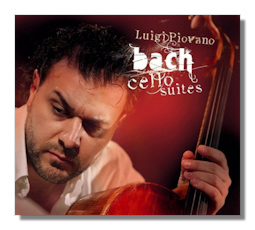
The Internet's Premier Classical Music Source
Related Links
- J.S. Bach Reviews
- Latest Reviews
- More Reviews
-
By Composer
-
Collections
DVD & Blu-ray
Books
Concert Reviews
Articles/Interviews
Software
Audio
Search Amazon
Recommended Links
Site News
 CD Review
CD Review
Johann Sebastian Bach

Suites for Unaccompanied Cello
- Suite #1 in G Major, BWV 1007
- Suite #2 in D minor, BWV 1008
- Suite #3 in C Major, BWV 1009
- Suite #4 in E Flat Major, BWV 1010
- Suite #5 in C minor, BWV 1011
- Suite #6 in D Major, BWV 1012
Luigi Piovano, cello
Eloquentia EL1021 2CDs 80:44 & 77:26 Spoken commentary in English and French
In the course of hearing these performances repeatedly, in comparison with recorded performances by Casals, Starker, Fournier, Rostropovich and Yo-Yo Ma, I have managed to get clear on what I want in performances of these important works. I also came to decide that I like what Piovano does, very much indeed. The absence in my comparisons of cellists notably identified with "historically informed" performance practice is duly noted. Please notice, though, that Piovano's uses a five-stringed cello from 1795 in Suite Six, as specified by Bach.
Even aside from the limitations of my sample, there is considerable variation among interpretations of these suites. There is no "standard" approach from which individual instrumentalists vary. ArkivMusic lists between 134 and 182 recordings of each of these suites. It would surely drive anyone mad who attempted to compare the six movements of each suite to all of the performances.
This said, prior to hearing Piovano, my first preference among the versions I knew was Starker, for his vigor, clarity and pace. Fournier has a subtlety that I have newly recognized, but his approach is too gentle for me. The early recordings by Yo-Yo Ma and Rostropovich, superb as they may be in other repertoire, disappointed me. Ma's performances I found too unrelenting and unvaried, and the youthful Rostropovich did not sound good to me at all. (I have not heard their later versions.)
So. Here is what I particularly want in these suites:
First, audible recognition that all of Bach's movements following the initial Preludes are dance forms;
Next, clearly articulated and compelling phrasing – not an unvaried succession of notes;
Third, subtle dynamic flexibility to add and maintain interest in the phrasing.
To my ears, Piovano's interpretations meet my requirements to an exceptional degree. When I listen to him play, I can visualize dances – not necessarily 18th century ones – that a choreographer might devise, sometimes with gentle swaying. From his instruments flow a wide range of expressive sounds, from a deep growl to quite a light touch, as I particularly noted in the Bouree of Suite 4. In the sixth suite, for the five-stringed cello (and which incidentally the least recorded) there are quite unusual sonorities. The recording venue was a church in Montepulciano in Tuscany, which will have had some effect on the recorded sound.
Piovano's phrasing is vigorous and varied; he gives emphasis to the notes that complete phrases or cadences, so that they are resonant rather than pinched; it seems to me that this helps make his interpretation danceable. Piovano's musical speech is well-modulated (as in a verbal sense) through dynamic subtlety rather than obtrusive tempo variation. Piovano does not introduce the kinds of pause that one can hear Casals make.
Luigi Piovano is the First Soloist Cello of the Symphony Orchestra of the National Academy of Santa Cecilia in Rome.
In sum, I find these satisfyingly musical performances. For those who might agree with my criteria, a highly recommended release. This is, for me, a "desert island" selection.
Copyright © 2011, R. James Tobin





















